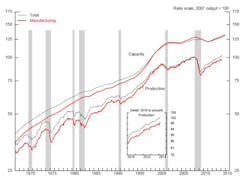Industrial production moved up 0.7% in March, the Federal Reserve reported, and the bank revised its February figure to 1.2% from 0.6% on the strength of durable goods manufacturing and mining production. The figure handily exceeded consensus estimates of a 0.5% improvement.
Manufacturing production in March moved up 0.5% to 98.7%, and factory output for February was revised from a 0.9% increase to 1.4%. For the first quarter, the index for manufacturing increased at an annual rate of 1.7%, the bank reported.
“Weather volatility aside, the monthly report on industrial production suggests that U.S. manufacturing is maintaining its path of moderate growth,” said Cliff Waldman, senior economist for the Manufacturers Alliance for Productivity and Innovation (MAPI), adding, "Manufacturing, which accounts for the lion’s share of total industrial production, grew a healthy 0.5%. While this is significantly slower than the 1.4% growth seen in February, weather-related distortions are clearly affecting these recent numbers."
Capacity utilization in March increased to 76.7% for the manufacturing sector, a rate 2.0% below its long-term average.
Durable goods production rose 0.4% in March, led by gains of approximately 2.5% in wood products and nonmetallic mineral products. Computers and electronics goods, aerospace, furniture and miscellaneous manufacturing all had gains of 1.0% or more.
With all major groups except food, beverage and tobacco products showing growth, nondurable manufacturing increased 0.7% in March. Apparel and leather goods, petroleum and coal products and textile and product mills showed increases of 2.5% or more.
Compared to March 2013, industrial production was up 3.8% last month and capacity utilization was 1.2% higher than a year ago. Manufacturing production was 2.8% higher in March 2014 compared to a year prior.
“Although domestic manufacturing continued a comeback from its winter doldrums, year-on-year growth is considerably slower than the 2012-13 levels, with no renaissance-like performance in sight," commented economist Alan Tonelson, a research fellow with U.S. Business and Industry Council.





